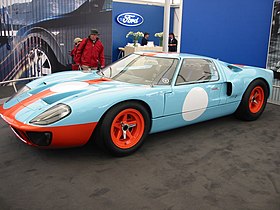
Back فورد جي تي 40 Arabic Ford GT40 Azerbaijani Ford GT40 Czech Ford GT40 German Ford GT40 Spanish Ford GT40 Finnish Ford GT40 French Ford GT40 Hungarian Ford GT40 ID Ford GT40 Italian
| Ford GT40 | |
|---|---|
 Ford GT40 Mk.I in JWA Gulf Oil racing colors | |
| Overview | |
| Manufacturer |
|
| Production | 1964–1969[1] 105 produced[2] |
| Assembly |
|
| Designer | Ron Bradshaw |
| Body and chassis | |
| Class | Group 4 sports car Group 5 sports car Group 6 sports prototype |
| Body style | 2-door coupé 2-door roadster |
| Layout | MR layout |
| Powertrain | |
| Engine | |
| Transmission | Mk1 & Mk3: 5-speed manual Mk2 & Mk4: 4-speed manual |
| Dimensions | |
| Wheelbase | 95 in (2,413 mm)[3] |
| Length | 160 in (4,064 mm) |
| Width | 70 in (1,778 mm) |
| Height | 40.5 in (1,029 mm) |
| Kerb weight | 1,800–2,300 lb (816–1,043 kg) (1966, Mk IIA)[4] |
| Chronology | |
| Successor | Ford P68 (racing heritage) Ford GT (street heritage) |
The Ford GT40 is a high-performance mid-engined racing car originally designed and built for and by the Ford Motor Company to compete in 1960s European endurance racing. It's specific impetus was to best Scuderia Ferrari, which had won the prestigious 24 Hours of Le Mans race for six years running from 1960 to 1965. Around 100 cars have been made, mostly as 289 cu in (4.7 L) V8-powered Mk Is, some sold to private teams or as road legal Mk III cars. Racing started in 1964, with Ford winning World Championships categories from 1966 to 1968. The first Le Mans win came in 1966 with two 427 cu in (7.0 L) powered Mk.II prototypes crossing the finish line together, the second in 1967 by a similarly powered highly modified US-built Mk.IV "J-car" prototype. In order to lower ever-higher race top speeds, a rule change from 1968 onwards limited prototypes to 3.0 litre Formula 1 engines; a loophole, however, allowed the private JW "Gulf Oil" team win at Le Mans in 1968 and 1969 running a Mk.I with a 5.0 litre engines.
The GT40 effort began in Britain in the early 1960s when Ford Advanced Vehicles began to build the Mk I, based upon the British Lola Mk6, in Slough, UK. After disappointing race results, the engineering team was moved in 1964 to Dearborn, Michigan, USA, to design and build cars by its advanced developer, Kar Kraft. All chassis versions were powered by a series of American-built Ford V8 OHV engines modified for racing.
In the 1966 Le Mans, the GT40 Mk II car broke Ferrari's winning streak, making Ford the first American manufacturer to win a major European race since Jimmy Murphy's Duesenberg in the 1921 French Grand Prix.[5][6][7]
The "GT" in the car's name stands for grand touring, and the "40" its height in inches (1.02 m) measured at the top of the windscreen, the minimum allowed. The first 12 "prototype" vehicles carried serial numbers GT-101 to GT-112. Production GT40s (Mk I, Mk II, Mk III, and Mk IV) began with GT40P/1000.
The contemporary Ford GT is a modern homage to the GT40, produced in two generations (beginning in 2005, and 2018).
The 2019 movie Ford v Ferrari is about the GT40's development and victory at the 1966 24 Hours of Le Mans.
- ^ Ford Chassis Numbers Retrieved on 27 January 2010
- ^ "Debut for 'last' GT40" Retrieved on 2 February 2017
- ^ Cardew, Basil (1966). Daily Express Review of the 1966 Motor Show. London: Beaverbrook Newspapers Ltd.
- ^ "GT40 Specifications". Archived from the original on 6 September 2012. Retrieved 29 November 2016.
- ^ "Ford GT40 Mark II". Supercars.net. 1 March 2004. Retrieved 24 September 2010.
- ^ "1965 - 1966 Ford GT40 Mk II - Images, Specifications and Information". Ultimatecarpage.com. 21 December 2006. Retrieved 9 August 2011.
- ^ "The ACO statistics of winners" (PDF). Archived (PDF) from the original on 27 June 2018.